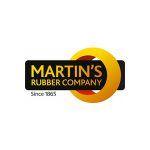What is the difference between injection moulding and compression moulding?
Many commercial and specialist rubber products are developed through a process known as rubber moulding. In this article, PIF spoke to the experts at Martins Rubber Company, in Southampton, to learn more about the difference between injection moulding and compression moulding techniques.
We will focus on the differences between rubber injection moulding and rubber compression moulding, how these techniques work and the main advantages and disadvantages of these techniques.
What is rubber compression moulding?
Martin's Rubber explains that "compression moulding is the oldest and simplest method of manufacturing a rubber product. It is often considered the most economical rubber manufacturing method". They go on to explain that compression moulding was developed as far back as the 1850s, but remains just as relevant today for manufacturing low to medium volumes of rubber products.
How does compression moulding work?
Martin's Rubber explains that "compression moulding works by combining heat and pressure to mould rubber into a shape". This results in the rubber being shaped by using a heated mould tool, and the clamping pressure of a press. As a result of this, chemical changes to the rubber, known as the curing or vulcanisation process, occur before cooling of the rubber takes place and extraction of the final finished part.
What are the advantages and disadvantages of compression moulding?
Compression moulding has a number of advantages and disadvantages, as with any manufacturing process. Martin's Rubber outlined the main ones to give us a clearer understanding of what to expect if you choose to use this technique.
Advantages of compression moulding
- Short set up time
- Minimal wastage
- Perfect for the manufacturing of parts with a very large cross-section
- Capacity to process stiff, high durometer materials
- Excellent for low quantities of parts requiring a long cure time
- Tooling is simpler and more cost-effective than injection moulding
Disadvantages of compression moulding
- Parts can be less consistent
- Coloured rubber can be easily contaminated
- Longer cure times
What is rubber injection moulding?
We asked the experts at Martin's Rubber to explain the injection rubber moulding process, how it works and what the advantages and disadvantages of this process are. They explained that injection moulding was created as an extension of the plastics industry in the early 1960s. This process involves injecting materials into a closed mould. As a result of this, it can be easily performed with a variety of materials including plastics, metals, glasses, and thermoset elastomers and polymers.
How does rubber injection moulding work?
Rubber injection moulding works by feeding the desired material into a heated barrel; where it is mixed and forced into a mould cavity where it cures and hardens into a specific shape. Moulds are usually made from steel or aluminium and are often the most efficient way to mould rubber.
What are the advantages and disadvantages of injection moulding?
Injection moulding comes with its own unique set of advantages and disadvantages. Here are the main advantages and disadvantages of injection moulding techniques.
Advantages of injection moulding
- Lower unit costs
- Faster cycle times
- Low levels of flash
- Small amounts of waste
- High dimensional tolerance
- Reduced need for secondary trimming
Disadvantages of injection moulding
- Higher set-up costs
- Small runs of parts can be costly
- More expensive machinery and tooling
Compression moulding Vs. Injection moulding
Martin's Rubber has the knowledge and expertise to help you understand which rubber manufacturing process is best suited to your needs. They explain that the choice between rubber compression moulding or injection moulding largely boils down to cost, volume and time pressures.
"Whilst neither technique is better than the other, the choice between injection or compression moulding relies heavily on the requirements of your product and it's application".
Speak to a Martins Rubber technical expert for guidance on the most suitable rubber moulding technique for your rubber products on +44 (0)23 8022 6330 or email [email protected] or visit the Martins Rubber website.
Get the latest process industry news
Interested in receiving even more industry-leading news from Process Industry Forum delivered directly to your inbox? Then sign up to our free newsletter. Bringing you the latest news, trends, innovations and opinion from across the process industry, our exclusive newsletter gives you all the industry insights of the moment in one, easy-to-digest bulletin. Stay ahead of the competition with regular process industry news instalments from PIF.

